
Go inside the studio as Restorations makes the most important album of its career
When a young music fan hears stories about their favorite bands recording new music, they often invent grandiose visions of the studio and its space. There’s a certain mystique inherent for those who haven’t stepped foot in one; like most unlived experiences it’s portrayed in our heads as distant, unattainable, a place where all-time art is created. A place where “regular people” don’t ever go. Of course, that’s not really true. Studios come in all shapes, sizes and budgets, from cavernous state-of-the-art compounds where million-dollar records are made, to dirt-floor basements walled with smoke-stained eggshell padding.
Philadelphia’s Miner Street Recordings, which has gone through several locations in its two decades of existence (and is no longer located on Miner Street, for the record – the name comes from its original location in West Chester), lies somewhere in between the two extremes of the studio spectrum. Situated at a central crossroads in Fishtown, it’s a nondescript, vaguely abandoned-looking building in a city full of them. Off-white and faded blue paint peels from the exterior walls, exposing bricks underneath. The only visual confirmation that it’s the right place is a small piece of black tape on the front door with the words “this is Miner Street” written on it.
Before spotting the “sign” though, there’s an aural confirmation; standing on the sidewalk outside, the sound of muffled, droned, noteless guitar strumming breaks through the walls. We’re here to observe Restorations as they record their third full-length and second for SideOneDummy Records, and even those distant, cacophonous non-notes are immediately identifiable with the band’s growing reputation for weaponizing sharp, bright melodies by weaving them into heavy, distorted riffs, an unassumingly thunderous rhythm section and the occasional organ, all of it anchored by the throaty vocals of Jon Loudon.

Jon Loudon tracking guitar for Restorations’ LP3 | Photo by Mitchell Wojcik | mitchellwojcik.com
This sound, simultaneously unique but familiar, abrasive but accessible, is the biggest reason why the band has gained so much momentum in the past two years or so, and what’s miraculous is that it all more or less happened by accident: the project was initially conceived as a part-time diversion for five guys in their late 20s and early 30s who had been in touring bands when they were younger. Now, their sound instead fills a previously undiscovered void within the punk scene.
Just as Loudon opens the Miner Street door, guitarist Ben Pierce and bassist Dan Zimmerman pull up, arriving back at the studio from a run to pick up a shiny new Fender bass. Zimmerman, like the other members of Restorations, is a total gearhead; his bass tracks for LP3 were already done and he’d come back to the studio to basically just talk about his new instrument with the other guys. Producer Jon Low quickly retrieves a guitar of his that shares the beige/black color scheme of Zimmerman’s new bass. “Hey Dan, you wanna join my band?” he cracks. They pose for a quick photo together, channeling the farmer in Grant Wood’s American Gothic in the way they hold up their instruments. Everyone laughs.
It’s apparent that this is not exactly the tense, high-pressure environment one might expect from a band on the rise recording arguably the most important album of their career. That levity is as much Low’s doing as it is anyone else’s. Though he’s worked on records from artists like The National, Sharon Van Etten and Kurt Vile, among many others, his kinship with Restorations goes beyond being just a guy behind the glass. He’s gone on tour with the band and has even joined them live on fourth guitar on occasion. Low has worked on all three of Restorations’ full-lengths thus far—he mixed their debut and produced LP2—and at this point, it’s hard to imagine their songs without his input.
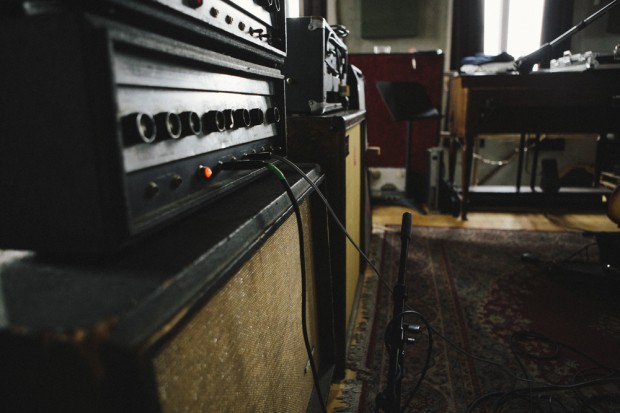
Restorations’ amps at Miner Street | Photo by Mitchell Wojcik | mitchellwojcik.com
For all the surface decay on the outside of Miner Street, the interior is beautiful. The upstairs recording space is large and open, with vaulted cathedral ceilings and hardwood floors. The walls, seemingly reaching high enough to touch the sky, are painted a deep sandy gray and broken up with a couple of large windows, which supply the overwhelming majority of the studio’s lighting. Mountains of gear—amps and guitars and basses and multiple drumsets—are spread throughout the floor. The sheer amount of stuff is almost too much to visually process, but at the same time, the space doesn’t feel cluttered or enclosing; there’s more than enough room for a band to play live if needed or desired. Low sits behind an expansive soundboard and a large computer monitor, peering at the main room through a rectangular window. In addition to Zimmerman’s bass being finished, drummer Carlin Brown has completed his tracks. Loudon’s guitars are next.
The first song of tonight’s session seems, at least at this embryonic stage, heavier and weirder than anything else in Restorations’ catalogue. Loudon’s guitar repetitiously punches and stabs the air around a thunderous rhythm section, creating urgency and tension with each passing chug. As he works through the part, Low occasionally chimes in through the control room microphone with advice.
“I think I like it better without the note,” he offers. “Yeah, fuck the note!” Loudon affably yells back. Low coaches Loudon to make his guitar work even meaner, telling him to lean into it and make it more abrasive and, in his own words, “skronky.” Because of their history and friendship, Loudon is extremely amenable to Low’s advice and trusts his judgment. He finishes his guitars in two takes.
The second song Loudon works on is initially brighter than the first. Guitarist Dave Klyman has been hanging out at the studio the whole time and occasionally assisting Low and Loudon with tone; he jokes from the control room with Pierce and Brown, who lives across the street and dropped by, that it sounds eerily similar to the NYPD Blue opening theme. Interestingly, the song delves into progressively slower and heavier territory, suggesting that the finished product will be at the very least, all-encompassing of Restorations’ many moods. Though this song is a little trickier than the first, Loudon still finishes his parts relatively efficiently. Work on a third song then commences, which Low cites as LP3’s “pop song” and one of his favorites of the ten tracks Restorations have written for this record. The phrasing draws a bit of sarcastic ire from Klyman: “Oh, this is our Frank Turner song isn’t it?” Indeed, the tone of the song is very different; the instrumentation is melodic, deliberate and catchy, and if Restorations were anything close to a “radio band” then this song might be the album’s lead single. Low opines to the control room that an acoustic guitar would sound good over the electric parts.
Once Loudon completes his parts for that third song, the album as a whole is nearly halfway done. He and the guys figure that’s a good place to stop, as next week he’ll begin to lay down vocals while Klyman and Pierce finish up their respective guitar parts. Completion seems within reach.
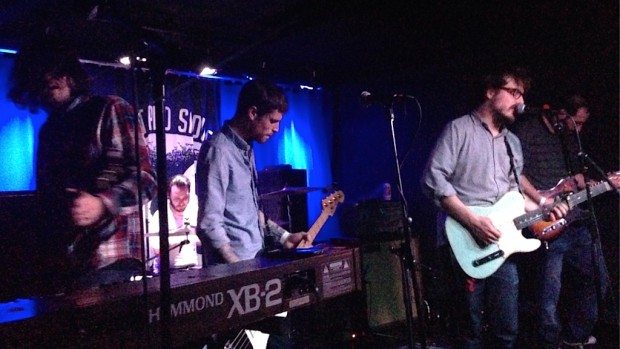
Restorations on stage at Boot and Saddle | Photo by John Vettese
It’s a Saturday night in South Philly, and elbow room is at a premium inside the 200-capacity venue Boot and Saddle. Restorations are headlining, and it’s their first time playing songs from their album-in-progress in front of an audience.
To make the event more exciting: whisperings around the internet earlier in the day indicated that the show was nervously close to a sell-out; the first time the band has ever packed a room to capacity on their own strength. Pierce and Zimmerman shuffle around the bar while opening act The Holy Mess plow through a snappy set; nobody seems to want to mention the words “sold out,” nobody wants to jinx it. But the evening reaches a point where the guys working door are no longer letting new customers inside. There’s an expression of delighted awe on Loudon’s face as he gently pushes his way across the crammed room and on the stage.
As the band kicked into their set, the crowd pushes to the front to take the new music in. A Restorations audience is a unique specimen; it doesn’t flail around in slam-dancing / crowd-surfing reckless abandon in the way you’d see at a show by their 2013 tourmates The Menzingers. But it is nonetheless engaged; you won’t spot any of the disaffected, distracted, arms-crossed dismissiveness that’s all too prevalent at indie rock shows (particularly in Philly). Eyes are locked on the stage and focused, mouths are snapped shut; a Restorations crowd listens and absorbs, and with the sheer volume of the new selections, there’s a lot to take in.
A total of five songs are debuted at the show, and in this setting, they come a cross like a invigorating, positive progression from where the band was at on 2013’s LP2. There was no “what the hell is this” moment for the crowd, no left turns so unexpected that listeners recoiled. It felt, blaring from the PA, like the band took an already well-crafted sound and built on it, refined it even further.
The following week, Loudon returns to the venue to talk about the experience over a grilled cheese with mushroom bacon and pub fries – the signature sandwich at the Boot and Saddle dining room. “We tried not to make too much of a big deal out of it,” he said of the band’s first sellout. “We just thought of the show as something our friends would go to, where we could hang out and just be bad and have it feel like a comfortable environment.”
Despite his modesty, Restorations was decidedly not bad the other night. But his point about the comfort level is an interesting one – the band plays relatively few hometown shows, maybe one or two a year. They’re seasoned enough to understand the concept of oversaturating their market, and they know that to keep the local crowd loyal, it’s best to have fewer shows that are more of an event. “If you play all the time, if you’re playing with any band that comes through and you’re playing whatever venue you can, at a certain point it doesn’t matter how good your band is,” Loudon explains. “It doesn’t matter how loyal your friends are. People just stop coming.”
Prior to the other night, Restorations’ ballpark attendance was around 100, Loudon says. Sometimes they like to play larger spaces and give their crowd a more comfortable experience – like the LP2 release party, a floor show in the 350 capacity basement of Philly’s First Unitarian Church. And playing in a town with so many musicians and musician-friends lends itself to helpful constructive criticism, Loudon says. “Hometown crowds aren’t afraid to tell you what they didn’t like about things, and we have a pretty good group of friends that will be super critical about it in a positive way, where you can kind of get a good perspective on everything.”
Which is, surprisingly, more relaxing and lower stakes for him than a tour date. “When we go out, we’re like ‘this show has to be as good as possible because we probably won’t come back here for a long time’,” Loudon says. Talk turns to the new songs, and it seems that the sense of building and refining something isn’t an accident. Loudon regards Restorations’ 2010 self-titled debut as more of a hodge-podge. “We took everything that we had wanted to do from other bands and sort of dumped them out and tried them all,” he says. “I think we’re able to look at those records now and we’ve set the boundaries for where the band can go.” Reflecting on the time spent in studio with Low, he says the band has been able to approach their sound more critically, dismantling it and pulling away the excess. “You don’t always need three guitars all the time,” he says.
A tool the band has taken to zeroing-in the optimal Restorations sound – when they’re on tour, Loudon says they play their own songs up against whatever records were in their own personal heavy rotation at the time, musing on how their songs compare and what ideas from their listening could be applied to improve things. “It’s hugely benefited us,” he says. “We’ll hear something and think ‘oh, this is really cool, how could we do this?’ It’s helped us realign how we view what we’re doing.”
So, what records have been shaping the growth of Restorations? Loudon says he’s been in a heavy punk phase, so The Bronx has been in the mix. The National, for their epic swell, has undeniably made an impact. Klyman likes The Libertines; Zimmerman likes Coldplay. “I’m listening to Coldplay records I never would have listened to in a million years,” Loudon laughs. “They’re surprisingly not bad!”
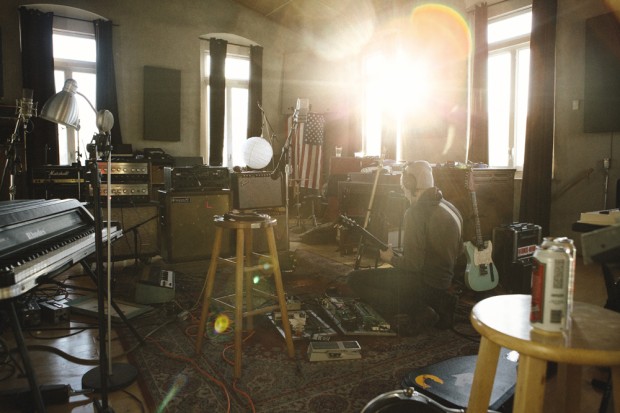
Restorations at Miner Street | Photo by Mitchell Wojcik | mitchellwojcik.com
It’s a week later, and Miner Street is a little quieter and less hectic. It’s earlier in the day, about 2 p.m. to be exact, and only Loudon and Low are at the studio.
“I’ve been a little under the weather,” Loudon says. “Might bail a little early today but Dave and Ben will be getting into some interesting stuff later. I’m doing vocals until I fall over”
Heading back into the friendly confines of the control room between vocal takes, there are noticeably more X’s on the whiteboard for LP3, including all of Loudon and Pierce’s guitar parts, as well as vocals on four of the ten songs. Loudon, trouper that he is, is recording vocals after an all-night bout with food poisoning. His singing voice, inherently weathered and raspy anyway, sounds as strong as it would otherwise to the untrained ear. The song he’s singing at the moment has a heavy and banging chorus that veers toward the dramatic in spurts. Low coaches Loudon to emphasize the words “future” and “before,” but otherwise the vocals come together rather seamlessly as Loudon belts out each one with more-than-respectable command for a guy on the mend. He’s also playing along to the song on an unplugged guitar, presumably for comfort. Low makes gentle fun of him for this between takes. A second song, which is slower and airier but with a bitingly heavy chorus, also comes together quickly. “Make sure you’re not rushing,” Low tells Loudon between takes. A true statement for recording vocals, and for life itself.
“Let’s do ‘Tiny’ then try one of the yelpier ones,” Loudon tells Low from the recording room. “Then I’ll blow out my voice for the day.” “Tiny” is a working title, and all of the songs have just those at this point, names like “Hummous,” “Rival Schools” and “Big Dick Sauce.” “This song has such a Constantines vibe,” Low tells me in the control room as Loudon sings. “The whole thing is one riff, with a repetitive verse/vocal pattern and those whoas.”
Constantines are a band to which Restorations are often compared, and not without reason; both groups have a sort of vaguely rootsy but heavy quality to them, and manufacture tension and catchiness in ways unconventional for most rock bands. Loudon is a huge fan, and has rarely if ever shied away from the comparison.
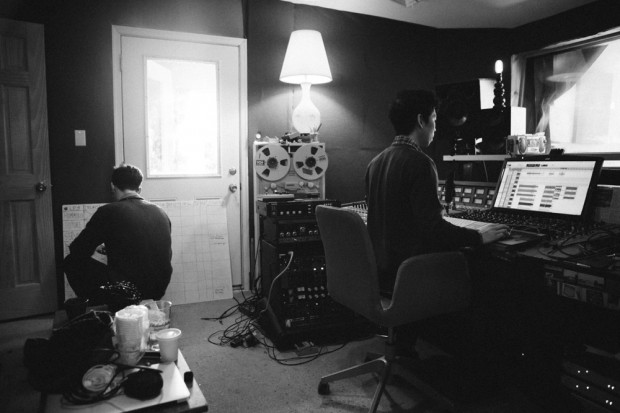
Producer Jon Low at the board, tracking the Restorations record at Miner Street | Photo by Mitchell Wojcik | mitchellwojcik.com
As Loudon’s voice begins to go, one of his final takes ends on an extra raspy whoa, which Low likes and keeps. There are some higher vocal notes in this song, and Loudon efforts to hit them, but he can’t quite get there today. No big deal, he’ll try again tomorrow.
“This is the most fun I’ve ever had making a record,” Loudon says in the control room as we listen back to some of his takes. “The lack of pressure, label-wise, has helped us a lot.” Indeed, Restorations endured a host of issues in that realm early on that could’ve derailed a weaker band; in 2011 they were set to record and release their debut full-length for Paper + Plastick, but some monetary issues on the part of the label led to self-financing of the record and an eventual release on Tiny Engines. They followed it up with the A/B 7-inch in 2012, which really caught the attention of SideOneDummy. 2013’s LP2, their debut for S1D, was met with wide critical and fan acclaim. “SideOne has been so cool to us. Not having to worry about who’s going to put out our record, or who’s going to pay for the recording, allows us to just focus on writing songs,” Loudon adds. “I think because there’s so little pressure, everybody in the band came into the studio amped to record and we’ve all played really well.”
Though the band came to the studio with nine of the ten songs more or less written, Loudon remarks, “Most of what we do [in the studio] aside from recording is spend a lot of time trying to find the best sounds and tones, and then adding stuff to songs that weren’t there before.” It’s interesting, the notion of a song never really being finished in a way, and it’s something that would become even more apparent after Loudon leaves and Klyman and Pierce return.
“Sir?” Klyman enters the control room, handing out cans of Tecate. “I don’t know about you, but 2:30 is my 5 o’clock.” Klyman spends his days working the magazine section at a large chain bookstore whose name you would recognize, and it seems that this time at the studio is when he can unwind the easiest. We start to reexamine the whiteboard. “At least nine songs will make the record. Even though SideOne pretty much lets us do what we want, I have a feeling they’d be pretty bummed if we turned in a six-song, 30-minute album,” he says.
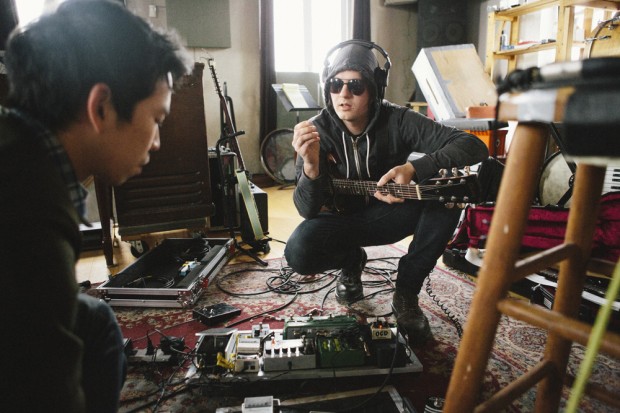
Restorations guitarist Ben Pierce at Miner Street | Photo by Mitchell Wojcik | mitchellwojcik.com
Right now, the outlier is a song with the working title of “Weird,” which according to him and Pierce, has yet to be mapped out by Loudon. Pierce is back at the studio to add organs and other keys to a handful of LP3’s songs, another Constantines-esque tool the guys enjoy having as a part of their sound. Also on the agenda for tonight are some of Klyman’s guitar leads; generally, any time you hear a wild solo in a Restorations song, it’s his handiwork.
A deep organ sound ebbs and wubs and flows from the recording space. The organ is underrated in its versatility within the context of rock ‘n roll; it has the ability to add gravity or levity to a song when needed. In Restorations’ case, it can go either way; this particular song has a long, slow buildup which Pierce is seeking to augment with dark keys. Low coaches him to make the keys heavier for this song, remarking that they’re too “pointy.” In another song, Pierce is using keys to add brightness and counter a heavy low end, similar to his work on LP2’s “Let’s Blow Up The Sun.” In a third song, the key tones reach near-psychedelic proportions, bubbling just under a vibrant guitar solo. It’s a little bit of a curveball, but sounds too cool and off-the-wall to not keep.
When Klyman begins tracking his guitars, the first thing that comes to mind is the surgical precision that’s often required to make a record sound really perfect. He plays take after take after take, something that doesn’t seem to bother him, Pierce or Low very much. While chipping away at a song with a working title of “Sep Songs,” Low tells Klyman, “Your guitar sounds a little ‘plunky’ in tone. Try to make it a little punchier, and don’t miss that extra note at the end.” Klyman concurs, and eventually hits a satisfying take. Upon listening back to it in the control room, he notices a slight mistake but remarks, “That imperfect note makes it sound more like a guy playing it in a room. I can live with that.”
Later on while working on another song, Klyman accidentally stumbles upon a bitingly unique solo part by mistakenly adding an extra note to it. “WHOA WHOA WHOA, what was that? That was awesome!” Pierce exclaims from the control room. Low agrees and asks Klyman to try and replicate it. After a couple of initial hiccups, he succeeds. It’ll likely end up being one of LP3’s most memorable moments.
It calls to mind the idea of songs never really being finished, and the sort of happy accidents that can occur in the recording process, whether it’s those imperfect notes as a grasp for humanization, or that moment when a mistake yields the potential for an even better, more arresting song. As Klyman attempts to piece together that solo he’d just accidentally written on the spot, Pierce listens intently from the control room couch. “Most bands don’t spend the amount of time, sometimes hours, searching for the right tone or part like this,” he says. “The same solo played over and over, looking for the perfect part and not quitting until we have it down. We love this stuff.”
Klyman continues his attempts at the newly written guitar part. Pierce continues to listen, at the ready for when he inevitably nails it. He turns to me and says, “Isn’t this great?”
